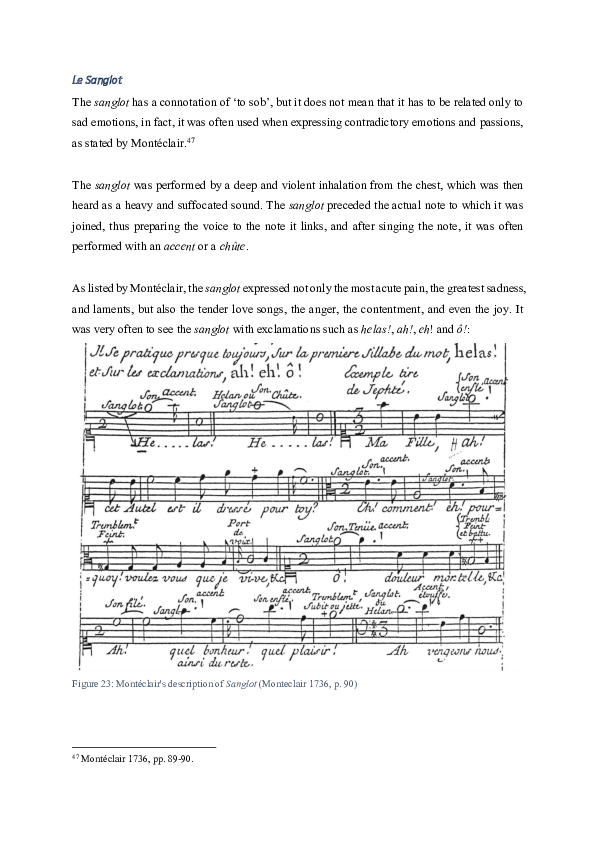L’Agrément, the small delicate ornament that is called grace in English music, also has the connotation of “to please”. The agréments were essential in a beautiful 17th-century air performance, but they were not always written in music. Bacilly listed nine types of vocal ornaments which were ordinarily never printed in music in his 1668 treatise:
The port de voix
The cadence(as distinguished from the ordinarytremblement, often called the flexion de voix.)
The double cadence
The demi-tremblement (also called thetremblement etouffé)
The soûtien de la voix(used on final notes and other long notes)
The expression (called passionner by the commoners)
Certain almostimperceptible repetitions of a note done with the throat, which is commonly called animer
The accent or aspiration (often called the plainte)
The diminution (used in passing from one note to another; ordinarily never printed in the simple version of an air and used only in the subsequent verses). Commoners call the diminution the Méthode de Chanter, thereby implying that the only purpose of singing consists of performing those things which they barbarously called the Frédon, the Roulementand other similar terms.1
In 1736, Montéclair published his Principes de Musique, where he listed eighteen types of agréments.
There are eighteen principle agréments in trained singing, the Coulé, the Port de Voix, the Chûte, the Accent, the Tremblement, the Pincé, the Flatté, the Balancement, the Tour-de-Goosier, the Passage, the Diminution, the Coulade, the Trait, the Son file, the Son enflé, the Son diminué, the Son glissé, and the Sanglot.2
Both Bacilly and Montéclair tried to explain in their treatises how these agréments work, when and where to use them. In Table 2 you can find a summary of the agréments in Montéclair’s treatise with the name, the sign, the expressive character, and the brief description of its usage.
Interestingly, apart from the port de voix, the accent, the tremblement and the diminution, there are little similarities between the two treatises in terms of the names and application of the agréments. In the following sections, I will briefly introduce some of the most important ornaments like port de voix and tremblement, and some ornaments that has an expressive character embedded in it, such as accent, chûte, coulé and sanglot, and compare between different treatises how they were described and executed in the 17th century.
We have now a basic overview of the 17th- and early 18th-century French vocal ornamentation. We have looked at how some of the ornaments were executed and in what condition we could apply them. It is clear that for Bacilly, for example, that some ornaments could only be applied in long syllables. As for Montéclair, he stated that some ornaments were used in certain expression, for example, that the coulé was never used in expressing anger. The omission of some more complex ornaments, the passages and the diminutions has been intentional, in the hope of narrowing the scope to better suit the intention of this research.
Part Two: Ornamentation in French vocal Music
List of French vocal Ornaments (1650-1750)
This chapter mainly focuses on listing the French vocal ornamentations. Selected ornaments will be discussed in detail.
Throughout this chapter the primary references I have consulted include the 1636 treatise Harmonie Universelle by Mersenne, the 1668 treatise Remarques by Bacilly and the 1736 treatise Principes de Musique by Montéclair. The contemporary reference includes Sally Sanford’s 2017 article ‘A Re-Examination of port de voix in the Seventeenth and early Eighteenth Centuries: Possibilities in Vocal Performances’.
3. L’Accent
6. La Chûte
7. Le Sanglot
Translation of the chapter Les Agréments from Montéclair’s Principes de musique (1736).3
Table 2: Les Agréments from Montéclair







